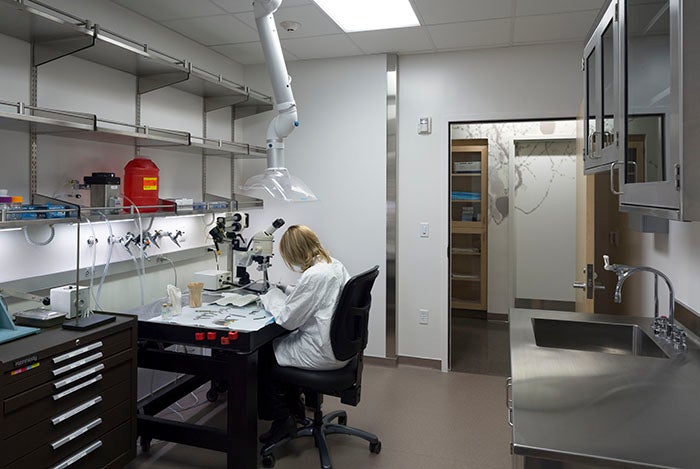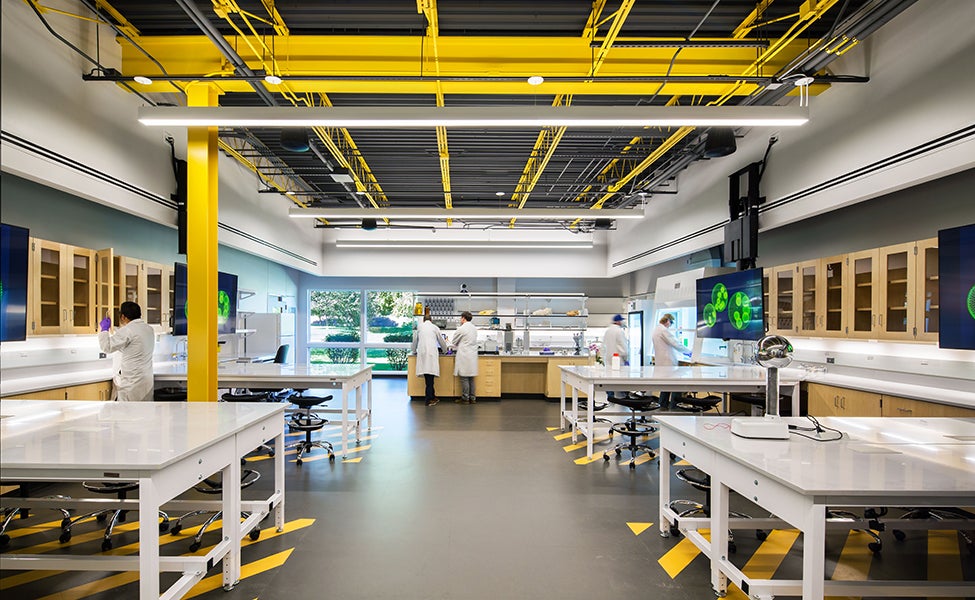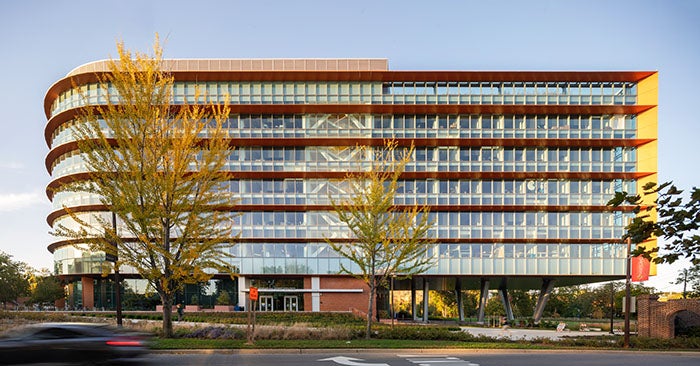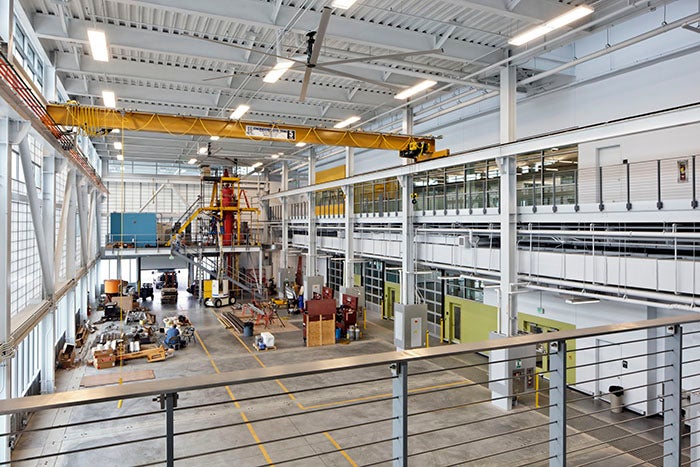
4 Forces Shaping Research Facility Strategy on Academic Campuses
What will the future higher education experience and academic research enterprise look like? What is the purpose of the physical, academic campus moving forward? These are questions that higher education institutions around the globe, particularly in North America, are considering right now. Many are taking a hard look at space utilization and whether the composition of their physical campus environment is fit to meet this moment and adapt to whatever the future might bring.
Through the many changes brought about by the pandemic, research remains a cornerstone of the academic enterprise and a key financial driver. For this reason, many institutions are taking a hard look at their campus infrastructure through the lens of how to drive more interdisciplinary collaboration, develop beneficial industry partnerships and create synergies that allow expensive research equipment and spaces to be shared. This article highlights the forces influencing the research ecosystem that should inform any academic research institution's strategic or master planning effort.
Force #1: A Shrinking Researcher Pool Puts Emphasis on "Attract and Retain"

The pandemic slowed much of the research happening on academic campuses. Labs shut down, and faculty and students delayed or pivoted during the first and second years of the pandemic. Today, both undergraduate and graduate admissions are down. The US News and World reports that "662,000 fewer students enrolled in undergraduate programs in spring 2022 than the previous spring — a drop of 4.7%, which is steeper than the decline in fall 2021." Furthermore, US schools saw a 72% decrease in new international student enrollment in 2020 compared to 2019. Many international students went home, and many did not come back. There are some concerns that international enrollment will never return to pre-pandemic levels, but that is yet to be proven out.
Regardless, many institutions face a much more competitive recruitment environment than before the pandemic, and the impetus to offer facilities that "attract and retain" top research talent is at an all-time high. Additionally, they may be looking for opportunities to attract a more diverse body of researchers and students to both align with their missions and DEI priorities and to address new requirements from federal agencies and private funders focused on broadening participation and enhancing diversity among faculty, researchers, and students in higher education.
Force #2: Research Productivity Relies on Increasing Undergrad Participation

Many institutions have ambitious goals of achieving Tier 1 status as that can help attract funding, research faculty, and students. They can only reach this status if they are doing enough research. Increasingly, undergraduate students are encouraged to engage in research, which can be a win-win for students and the institution. Undergraduate research is academically attractive and can help attract new students in a competitive environment, but it also helps fuel the vast amount of research that needs to happen at grant-based and faculty-driven universities.
Perhaps a sign of things to come, the Ivy League institutions shifted to a research-based institutional model years ago, and we predict that more top-tier research institutions will do the same in the coming years. No matter the particularities of how this plays out for any single institution, one thing is certain: in the future, research and undergraduate programs will co-exist in new ways and academic programming, facilities management and student services must work collaboratively to manage this change.
Force #3: Interdisciplinary Innovation, Venture Capitalism Drive Economic Viability

Advancements in biomedical technologies, sustainable energy alternatives, improved food. safety, increasing AI and robotic technologies, and securing cyberspace are just a few examples of societal challenges that require interdisciplinary collaboration and innovation. Take the impact of climate change on food crops. This is not solely an issue for biology or agriculture or ecology. It takes a mixture of many disciplines and scientific backgrounds to tackle this type of research. As a result, the emphasis on interdisciplinary collaboration is happening at every level of the institution: from pedagogy to operations to facilities.
Part of the incentive to embrace interdisciplinary collaboration and innovation is financial. Higher education institutions are receiving more and more funding for innovation through venture capitalism and grants. According to PitchBook, since 2006, start-up founders at the top 50 undergraduate programs have created nearly 24,000 companies and raised over $660 billion in capital.
This venture capitalism creates more demand for research, development and innovation on campus and more shared facilities between engineering, traditional physical science disciplines, life sciences, and even social sciences. It also prompts many institutions to look at non-traditional real estate strategies to help cover costs. For example, research parks are a popular undertaking for space adjacent to college campuses and can be a way of attracting private money to fuel academic research. Many of these developments are Public-Private Partnerships (P3s) that reduce some of the costs associated with the cost of space. These developments seem to be more successful at campuses where research is already robust. For example, at the University of Maryland, the Discovery District has successfully provided spaces for a hotel and other amenities that support the university but are funded by outside sources. And, oh yes, there's research space too.
Force #4: Climate Change is a "Here and Now" Emergency

In recent years, there has been a stark realization of just how serious our climate emergency is. It has left higher education, like many other industries, scrambling to get more robust and aggressive plans in place. Many institutions have signed a commitment that focuses on the 2050 carbon-neutral goal, but to meet that goal, they will need to reinvent their campus infrastructure. It's an expensive undertaking.
Ideally, institutional leadership should integrate climate action plans into other master and strategic planning efforts on campus. Research facility strategic and master plans represent an excellent opportunity to make climate action plans actionable. Research buildings, with their higher energy use intensity (EUI), are often one of the primary culprits for campus carbon emissions, and as such, represent one of the best opportunities for reduction.
We know many things about the current focus on the research enterprise on campus. And there are also things we are still learning. How can DEI priorities be realized in the research master planning efforts? How can we integrate a robust understanding of student and researcher mental health and well-being into these plans, particularly in the wake of the pandemic? We are already tackling these questions with some of our clients and are eager to explore them with other institutions.
So now that we have identified some of the things that got us here, what digital and strategic tools can give higher education institutions assurance that taking the leap with a research facilities master plan will have financial and organizational benefits? How do we proceed forward when assessing the research enterprise as a whole or a single component, such as physical sciences or vivaria? In upcoming articles, we will provide key considerations for data-driven research facilities master planning efforts.




